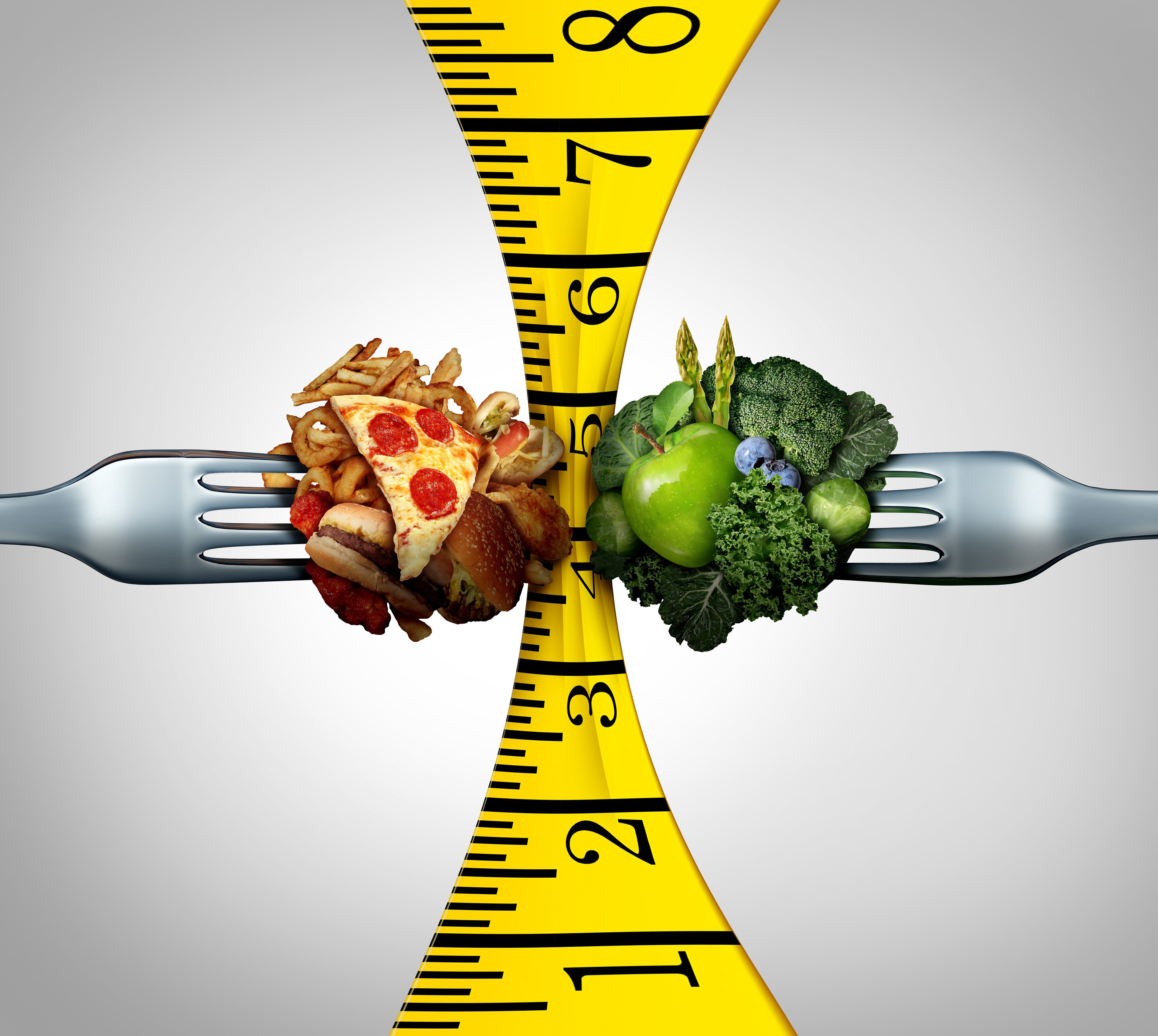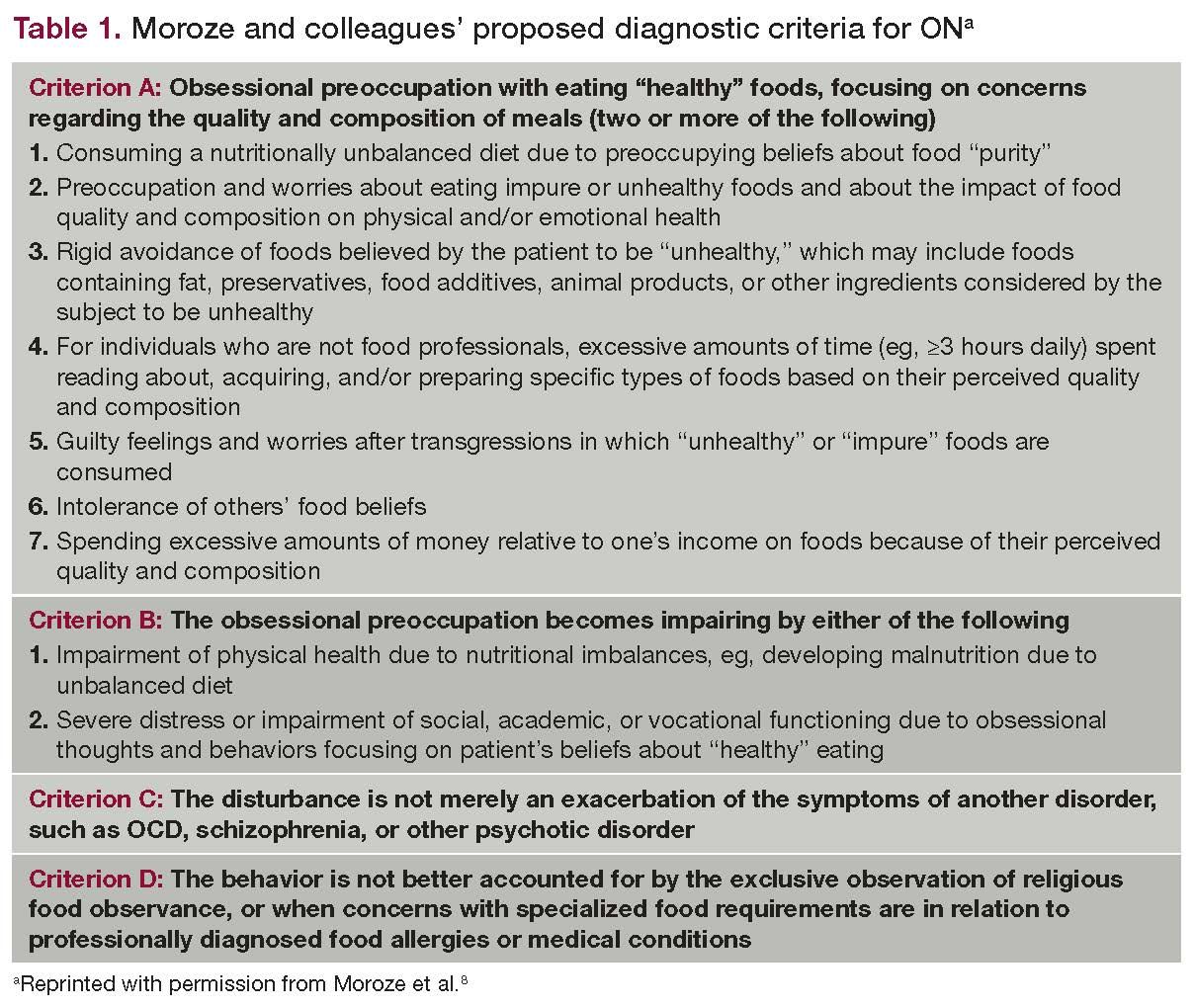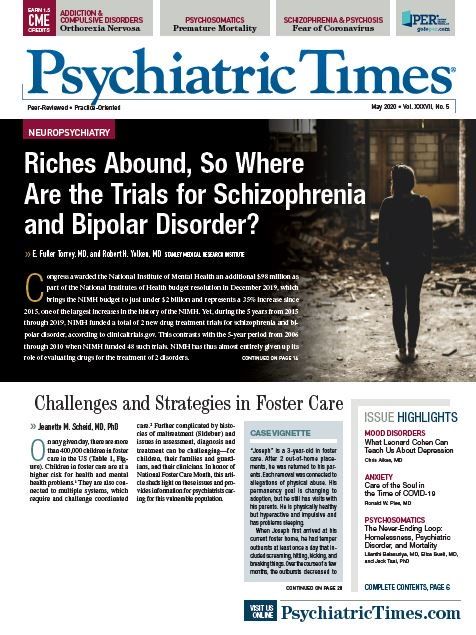Publication
Article
Psychiatric Times
Orthorexia Nervosa
Author(s):
With increasing interest in pathologically healthful eating, there is considerable need for additional research and psychiatrists who can diagnose and treat orthorexia nervosa (ON).

Table 1. Moroze and colleagues’ proposed diagnostic criteria for ON

Table 2. Dunn and Bratman’s proposed diagnostic criteria for ON

Pathologically Healthful Eating or Pathologizing Healthy Eating?
Premiere Date: May 20, 2020
Expiration Date: December 20, 2021
This activity offers CE credits for:
1. Physicians (CME)
2. Other
All other clinicians either will receive a CME Attendance Certificate or may choose any of the types of CE credit being offered.
ACTIVITY GOAL
The goal of this activity is to provide an understanding of orthorexia nervosa.
LEARNING OBJECTIVES
After engaging with the content of this CME activity, you should be better prepared to:
• Discuss the problems associated with pathologically healthful eating.
• Recognize that orthorexia nervosa is distinct from other eating disorders.
• Define the diagnostic criteria that exist for orthorexia nervosa.
TARGET AUDIENCE
This continuing medical education (CME) activity is intended for psychiatrists, psychologists, primary care physicians, physician assistants, nurse practitioners, and other health care professionals who seek to improve their care for patients with mental health disorders.
ACCREDITATION/CREDIT DESIGNATION/FINANCIAL SUPPORT
This activity has been planned and implemented in accordance with the accreditation requirements and policies of the Accreditation Council for Continuing Medical Education (ACCME) through the joint providership Physicians’ Education Resource®, LLC and Psychiatric Times. Physicians’ Education Resource®, LLC is accredited by the ACCME to provide continuing medical education for physicians.
Physicians’ Education Resource®, LLC designates this enduring material for a maximum of 1.5 AMA PRA Category 1 Credits™. Physicians should claim only the credit commensurate with the extent of their participation in the activity.
This activity is funded entirely by Physicians’ Education Resource®, LLC. No commercial support was received.
OFF-LABEL DISCLOSURE/DISCLAIMER
This CME activity may or may not discuss investigational, unapproved, or off-label use of drugs. Participants are advised to consult prescribing information for any products discussed. The information provided in this CME activity is for continuing medical education purposes only and is not meant to substitute for the independent clinical judgment of a physician relative to diagnostic or treatment options for a specific patient’s medical condition.
The opinions expressed in the content are solely those of the individual faculty members and do not reflect those of Physicians’ Education Resource®, LLC.
FACULTY, STAFF, AND PLANNERS’ DISCLOSURES
The authors, Katharine Phillips, MD (external peer reviewer), and the staff members of Physicians’ Education Resource®, LLC and Psychiatric Times have no relevant financial relationships with commercial interest.
For content-related questions, email us at PTEditor@mmhgroup.com; for questions concerning the accreditation of this CME activity or how to claim credit, please contact info@gotoper.com and include Orthorexia Nervosa: Pathologically Healthful Eating or Pathologizing Healthy Eating? in the subject line.
HOW TO CLAIM CREDIT
Once you have read the article, please use the following URL to evaluate and request credit for this activity: https://education.gotoper.com/activity/ptcme20may. If you do not already have an account with PER® you will be prompted to create one. You must have an account to evaluate and request credit for this activity.
There is increasing interest in pathologically healthful eating, so called orthorexia nervosa (ON). Those with the condition develop patterns of dysfunctional eating based not on the quantity of food that they eat, but on its quality. These individuals report having disrupted social interactions and/or are malnourished and/or underweight because of their obsession for eating healthfully.
Although weight loss may be a favorable feature of healthful diets, these individuals do not have a disrupted body image, nor a drive for thinness. Instead, intake is restricted based on the belief that by eating only certain foods they are healthier. ON is not codified by a major classification system, such as DSM or International Classification of Diseases, and it does not meet the criteria for anorexia nervosa (AN), bulimia nervosa (BN), or avoidant/restrictive food intake disorder (ARFID). Because ON is not an official diagnosis, individuals whose healthful eating is causing health problems or disruption in daily functioning should be given the diagnosis of “other specified feeding and eating disorder,” which would have been “eating disorder not otherwise specified” before DSM-5.
A brief history
The term orthorexia nervosa was coined in 1997 by the alternative medicine physician Steven Bratman, MD, MPH; it is based on the Greek terms “ortho” meaning “correct” and “orexis” meaning “appetite” to describe individuals whose drive for healthy eating has resulted in malnutrition or social impairment.1 Bratman describes a period in his life where his drive for a diet to help him be clear headed and strong drove him to a preference for food that had been harvested from the ground less than 15 minutes before eating it. When he was obsessively scrabbling the ground for vegetables, he ultimately realized that his diet-and self-righteousness about it-was leaving him lonely and depressed. He also realized that there were others with similar behaviors. In 2000 he wrote the book, Fast Food Junkies.
With the exception of a JAMA review of Bratman’s book, ON was largely unknown to most academics and practitioners. Work in the area would languish until 2004, when a group of Italian investigators published research on what they referred to as a “maniacal obsession for healthy foods.”2 Their work led to a later publication introducing “ORTO-15,” an instrument designed to detect ON. Using this instrument, they suspected that roughly 6% of a community sample in Italy met the criteria for ON. A blizzard of papers followed, all generally trying to estimate the prevalence of the condition among different samples. Many of these studies were conducted in other countries and required ORTO-15 to be translated into other languages.
Much of the work carried out with ORTO-15 (or a derivative) showed a very high prevalence in community samples for a type of disordered eating that was largely unknown to eating disorder specialists. Many of these studies reported an absurdly high prevalence, such as nearly 89% in a Brazilian study, 86% in a Spanish sample, and 69% in a German study.3
Eventually, it became clear that ORTO-15 does not truly measure pathologically healthful eating and has poor psychometric properties, and it fell out of favor with serious ON researchers.4 Most studies involving ORTO-15 or a derivative are highly suspect. Unfortunately, the bulk of the conclusions drawn about ON, in particular its prevalence, comes from these studies.
More recently, a 2017 study identified individuals in a college sample who endorsed excessive healthy eating, and highlighted their resulting malnutrition/being underweight or significant impairment in social functioning as a consequence of the diet. The investigators estimate that the true prevalence of ON is less than 1%, which puts it on a par with AN and BN but makes it less common than binge eating disorder.5
Pathologically “healthy” eating
Case studies in the literature detail patients with severe health complications who used diet to control medical conditions. In one case, profound medical complications (including hyponatremia, pancytopenia, pneumomediastinum, and pneumothorax) were seen in a 30-year-old man.6 His restricted eating consisted of limited amounts of brown rice and fresh vegetables for the exclusive purpose of treating a tic disorder.
In a second case, severe malnutrition and a body mass index (BMI) of 10.7 were seen in a 28-year-old woman. To treat her acne, she had been eating only uncooked vegetables after slowly reducing items she would eat-a nutritionist had suggested removing fats from her diet.7
Finally, a third case involved a 28-year-old man whose drive for achieving purity and health by dieting resulted in severe malnutrition and a BMI of 12.3.8 This last case study was notable in that it was the first to appear in a mainstream US psychiatric journal and the first to codify proposed diagnostic criteria in a peer-reviewed publication.
Diagnostic criteria
There are 4 different proposed diagnostic criteria sets meant to identify individuals suffering from ON; 3 have been developed since 2015. The earliest set was developed by a US dietitian in a self-published quick reference guide for health care providers. It is not in wide circulation, nor has it been peer reviewed. There are also criteria developed by Barthels and her group that are published in German.9 The most widely cited criteria are those put forth by Moroze and colleagues8 (Table 1) and those generated in a later publication by Dunn and Bratman3 (Table 2).
The prominent features of the proposed criteria sets are as follows:
• Preoccupation with nutrition or healthy eating resulting in malnutrition, health complications, being underweight, and/or social impairment;
• Drive for health and not for thinness; no disrupted body image;
• Anxiety, even panic, about unhealthy food;
• Guilt or distress after violating diet;
• Insistence on eating a “healthy” diet despite resulting medical complications;
• Rigid avoidance of unhealthy foods;
• Unrealistic ideas about how foods can cure disease or promote health ;
• Fears about not eating healthfully reduced by ritualized preoccupation with food;
• Positive sense of self strongly associated with compliance in self-imposed healthy dieting;
• Sense of superiority over others because ones own diet is better.
All of the proposed criteria sets include important exclusions. For example, caution is warranted in applying ON in instances where intake is restricted based on food allergy, food intolerance, or on religious beliefs. ON would also be an inappropriate diagnosis for an individual whose presentation is due to another psychiatric condition, such as someone with schizophrenia that includes delusional beliefs about the benefits of food.
Although ON is distinct from AN, the two share significant overlap. Both conditions start with a sensible premise. For individuals with AN, it is sensible to avoid obesity, and for ON, it is sensible to have a healthy diet. In both conditions, however, individuals transition to pathological dieting that may affect their health or cause clinical impairment. It is our experience that both conditions involve a denial on the part of individuals about the functional impairment of their diet and have significant obsessive-compulsive features.
Although evidence is lacking, we have observed that traits of perfectionism, inflexibility, and extremism (refusing to see other points of view) are present in both conditions, as are deeply held ideologies that help provide order and structure to one’s life and help exert control over their environment. Finally, based on clinical observations, both patients with ON and patients with AN tend to be achievement oriented and can have cognitive distortions about food.
ON is also different from ARFID. Although patients with ARFID become malnourished or underweight because of their food intake, the majority of those patients restrict their intake because of an aversive experience that they have had with food. Aversion is defined in the classical conditioning sense that eating has become paired with a noxious experience, such as choking, vomiting, or constipation. Less frequently, those with ARFID are underweight because of extremely picky eating, or objections to the sensory properties of food. Based on case studies of ON, none of these properly accounts for individuals whose “healthy” diet is so strict that they become malnourished, develop medical complications, or whose social functioning is affected.6,8
Treatment approaches
Treating individuals with ON can be difficult. To our knowledge, there are no research studies on the treatment of ON; thus, no evidence-based treatment guidelines are available. Those with the condition often do not present themselves for treatment. Society seems to praise “healthy eating” and may not be as concerned about disordered dieting. Moreover, those with ON commonly see themselves, and their approach to healthful dieting, as being morally superior to others and proudly extol their diet.
Those whose health is in peril because of their diet present for care because dieting has led to malnutrition and subsequent medical complications. There are other treatment challenges. Not only can these individuals have poor insight, they are often bombarded with messages about healthful eating that contradict treatment options for their recovery.
When it comes to treating patients with ON, interventions should be individualized and based on the symptoms that are prominent for a given patient. It is critical to work with a dietitian when setting up a care plan. Cognitive restructuring is likely beneficial for dichotomous thinking, overgeneralization, catastrophizing, and other cognitive distortions surrounding food, eating, and health.
Relaxation training may assist with pre- and postprandial anxiety. Behavior modification strategies are also helpful. These strategies include systematic desensitization (patients gradually work up to eating food that causes them anxiety), flooding (early on in treatment insisting that patients eat “unhealthy” food and later process the experience), and positive reinforcement (providing a reward for achieving a goal related to eating).
Flooding is effective with inpatient care, but outpatients and day patients tend to respond better to systematic desensitization and positive reinforcement. These interventions may be useful to expand one’s food repertoire, increase socialization during meals, and diversify activities not spent in pursuit of health.
Psychoeducation about empirically validated dietetic science may help disabuse patients with orthorexia of false food beliefs. Patients with ON typically have endless environmental triggers, such as coming down with a cold, odd aches or pains, and perceived changes in mood and energy level. Identifying these triggers can be beneficial. For example, the patient can be taught to normalize minor health complications as a typical part of life or to avoid following those on social media who are fervent about being healthy. Identifying and coping with triggers are excellent topics for both individual and group psychotherapy.
Dysfunctional family relationships may prompt rigid dieting as a coping mechanism for some patients with ON. Conversely, patients can develop a sense of superiority over others and can provoke strife by judging their diet choices. Family therapy can help manage conflict among family members and sometimes deal with the root of family dynamics that leads to rigid dieting. Family therapy can educate family members about the nature of ON and provide coping skills to deal with the patient’s sense of superiority.
A search through the literature shows only one article on using psychiatric medication to treat ON. Moroze and colleagues8 were treating a young man who had a pathological focus on the micronutrient content of his food, including trace elements such as copper and molybdenum. He was found to perseverate on the purity of the food he ate and spoke at length about the magical health properties of broccoli. Such a diet led to significant weight loss and at the time of admission the patient was at 50% of his ideal body weight. After psychiatric evaluation, he was started on olanzapine titrated to 10 mg twice a day. Upon discharge, the patient’s delusional beliefs about food were gone, as were his obsessional thoughts about dieting. (Although olanzapine is not FDA approved for the treatment of eating disorders, our psychiatry colleagues inform us that it is not off label to use it to treat delusions.)
Conclusion
Clinicians are probably encountering patients like the young woman in the second case. Pathologically “healthy” eating is a distinct nosological entity that does not meet criteria for either AN or ARFID. There are high-risk populations for ON, such as athletes and others who are focused on being healthy; however, most of those individuals will only experience social impairment. On the other hand, individuals who view food as medicine are at increased risk for life-threatening medical complications and even death.
Although it is certainly not a common outcome, severe malnourishment can develop in some patients with ON as the diet designed to treat their medical condition or promote “good health” becomes so restricted that they do not get sufficient nutrition to sustain life. An even smaller minority of patients succumb to their medical condition because they avoid mainstream (often curative) treatment, believing their strict diet will lead to a better outcome. Given these stakes, there is considerable need for additional research and for psychiatrists who can diagnose and treat the condition.
CME POST-TEST
Posttest, credit request forms, and activity evaluations must be completed online at https://education.gotoper.com/activity/ptcme20may (requires free account activation), and participants can print their certificate or statement of credit immediately (80% pass rate required). This website supports all browsers. For PER®’s privacy policy, please visit https://www.gotoper.com/privacy.
PLEASE NOTE THAT THE POSTTEST IS AVAILABLE ONLINE ONLY ON THE 20TH OF THE MONTH OF ACTIVITY ISSUE AND FOR 18 MONTHS THEREAFTER.
Disclosures:
Dr Dunn is Professor, School of Psychological Sciences, University of Northern Colorado, Greeley, CO; and Staff Psychologist, Denver Health Medical Center; Dr Hawkins is Chief Executive Officer and Licensed Psychologist, Center for Change, Orem, UT.
References:
1. Bratman S, Knight D. Health Food Junkies. New York: Broadway. 2000; 42-50.
2. Donini L, Marsili D, Graziani M, et al. Orthorexia nervosa: a preliminary study with a proposal for diagnosis and an attempt to measure the dimension of the phenomenon. Eat Weight Disord. 2004;9:151-157.
3. Dunn TM, Bratman S. On orthorexia nervosa: a review of the literature and proposed diagnostic criteria. Eat Behav. 2016;21:11-17.
4. Missbach B, Dunn TM, König JS. We need new tools to assess orthorexia nervosa. A commentary on “prevalence of orthorexia nervosa among college students based on Bratman’s test and associated tendencies.” Appetite. 2017;108:521-524.
5. Dunn TM, Gibbs J, Whitney N, Starosta A. Prevalence of orthorexia nervosa is less than 1%: data from a US sample. Eat Weight Disord. 2017;22:185-192.
6. Park SW, Kim JY, Go GJ, et al. Orthorexia nervosa with hyponatremia, subcutaneous emphysema, pneumomediastimum, pneumothorax, and pancytopenia. Electrolyte Blood Press. 2011;9:32-37.
7. Zamora MLC, Bonaechea BB, Sánchez FG, Rial BR. Orthorexia nervosa: a new eating behavior disorder? Actas Españolas de PsiquiatrÃa. 2005;33:66-68.
8. Moroze RM, Dunn TM, Holland JC, et al. Microthinking about micronutrients: a case of transition from obsessions about Healthy eating to near-fatal “orthorexia nervosa” and proposed diagnostic criteria. Psychosomatics. 2015;56:397-403.
9. Barthels F, Meyer F, Pietrowsky R. Die Düsseldorfer Orthorexie Skala–Konstruktion und Evaluation eines Fragebogens zur Erfassung ortho-rektischen Ernährungsverhaltens (in German). Zeitschrift Klin Psychol Psychother. 2015;44:91-105.







